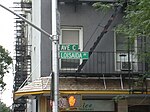Eleventh Street Methodist Episcopal Chapel

Eleventh Street Methodist Episcopal Chapel, also known as the People's Home Church and Settlement, Russian Ukrainian Polish Pentecostal Church, and Father's Heart Ministry Center, is a historic Methodist Episcopal chapel located in the East Village neighborhood of Lower Manhattan, New York City. The chapel was built in 1868–1869, and is a raised two-story, three bay, gable front brick building. Originally constructed in a vernacular Gothic Revival style, it was altered between 1900 and 1901 in the Colonial Revival style. Associated with the chapel is the former rectory. It was built about 1856 as a four-story, three bay single family dwelling in a vernacular Greek Revival style. The rectory was converted to a settlement house in 1900–1901.: 3, 5 It was listed on the National Register of Historic Places in 2011.
Excerpt from the Wikipedia article Eleventh Street Methodist Episcopal Chapel (License: CC BY-SA 3.0, Authors, Images).Eleventh Street Methodist Episcopal Chapel
Avenue B, New York Manhattan
Geographical coordinates (GPS) Address Nearby Places Show on map
Geographical coordinates (GPS)
| Latitude | Longitude |
|---|---|
| N 40.727777777778 ° | E -73.979722222222 ° |
Address
Avenue B 180
10009 New York, Manhattan
New York, United States
Open on Google Maps





